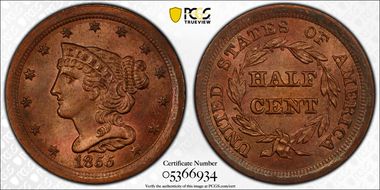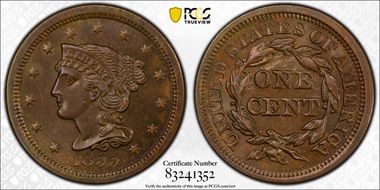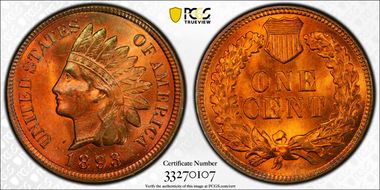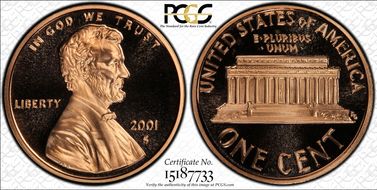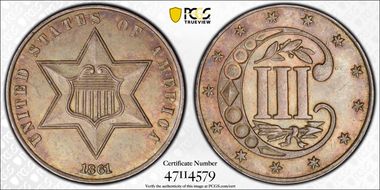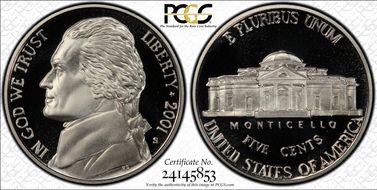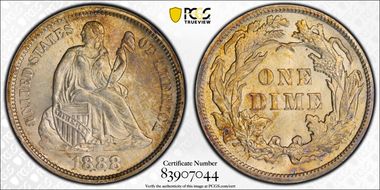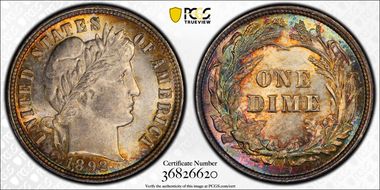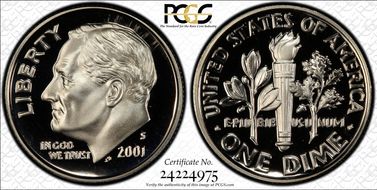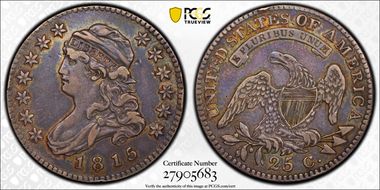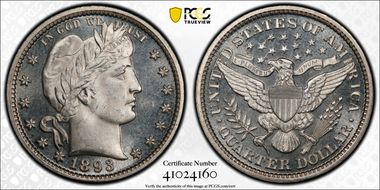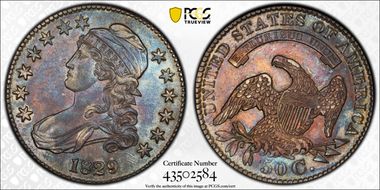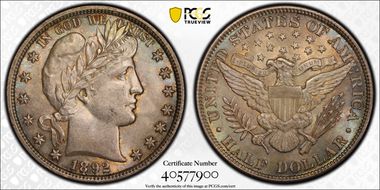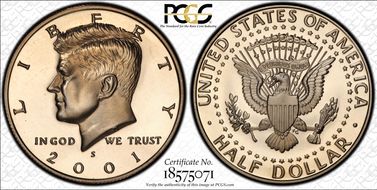Paterson Ancestry in the United States 的钱币相册
The 1855 Half Cent has the third highest mintage of the Braided Hair series. It is a common coin in most grades, up to and including MS-64. Gem Mint State examples are scarce but not rare. Of all the dates in this series, the 1855 is the most common in full Red condition...by far. PCGS has certified over two hundred Red examples, mostly in MS-64. Thus, for type collectors, this is a go-to date for exceptional color and quality. Both of the 5's in the date are slanted, which was typical of the 1850-1855 Half Cents. In 1856 a new font with an upright 5 was used. Only one die variety (Cohen 1) is known for this year.
1855 Large Cents come with two different date styles -- one has slanted 5's and the other has upright 5's. In all of the years preceding 1855, the 5's had some degree of slant, though perhaps not to the degree as seen on the 1855's. Both Slanted and Upright 5's are found on 1856 Large Cents, then the issue is settled with the 1857, which has Upright 5's only. The end of the Large Cent denomination after 1857 sealed their fate. According to the PCGS Population Report (as of March 2012), the Upright 5s variety is the more common of the two, though hundreds have been certified of each. No 1855 Large Cent (of either type) has earned a grade better than MS-66, and that includes all color variations. Amazingly, a handful of Full Red Gem examples have survived to satisfy and excite collectors.
The 1893 Indian Cent has an average mintage more or less. As there are several issues from the series which have significantly lower or higher mintages. This issue appears to be scarce in MS65 condition with no more than a few hundred known in this condition. In MS66 it is even scarcer with about 100 or so examples known. Anything grading higher is considered a condition census coin and less than a few dozen or so known grading higher than MS66.
The 1888 Three-Cent Nickel boasts the last of the "big" mintages from the 1880's, but at 36,501 pieces, the mintage is still tiny by any standard. This date compares favorably with the 1879, which has just a slightly higher mintage; both dates are priced nearly the same in all grades. Numerous Gem examples exist of this date, with dozens available in MS65, MS66, and MS67. In MS68, the population drops down to a mere one -- a lovely PCGS MS68 (which ranks as the finest known of this date). In general, this date comes well struck, and almost always shows all of the vertical lines in the Roman numeral III on the reverse. Picky collectors should select pieces with booming luster and as few carbon flecks as possible.
The 1861 Three Cent Silver has the highest mintage of any date in the 1860s, but this is a relative term, since the 1852 (the most common date in the series) has a mintage that is 375 times that of the 1861. This disparate relationship does not translate to the PCGS Population Report, where the census of the 1852 is only twice that of the 1861, but this is due to the fact that most circulated examples never make it to the grading services. The PCGS Condition Census contains a full complement of MS67 examples, meaning that collectors can find some wonderful examples on the market. The 1861 usually comes well struck, seldom with clashmarks, and often with rich, frosty luster. For type purposes, this is a great date, and one that offers excellent value.
The 1876 Shield Nickel has a slighter higher mintage than the 1875, and is slightly less valuable in all grades, mostly due to higher populations. Like most of the common Shield Nickels, this date is seen most frequently in MS-64, can be found withtout too much difficulty in MS-65, becomes scarce to rare in MS-66, and is unobtainable finer. As usual, this date comes with some interesting die cracks. Look for coins that show intense luster and which are as free of spots as possible.
In circulated grades, the 1920 is about as rare as the other 1914 to 1924 era Philadelphia Mint Buffalo nickels. In uncirculated and Gem uncirculated condition, it is rarer than the 1914-1919 P Mints, with the exception of the rarer 1918. It is slightly rarer than the 1921 in Gem condition. Most 1920s are fairly well struck. Luster is more frosty than satiny.
The 2001-S Proof Jefferson Nickel is considered fairly common since more than enough proof coins were struck to meet the collectors demands. Most examples come well struck and examples up to PR69 and PR70 deep cameo are fairly affordable and easy to find. Pop. 451/0 (6/14) Mintage: 2,294,043.
The 1871 Half Dime is one of the most common dates in the series, though it is not as plentiful as dates such as 1837 Large Date, 1853 With Arrows, 1857, 1858, 1860, and 1872-S (Mintmark below wreath). Likewise, Mint State examples are reasonably plentiful, especially in the MS63 and MS64 grades. A dozen or so MS66 examples are known, but PCGS has certified only one MS67 example, with none finer (as of March 2011).
The 1892 Dime is the first date of the new type designed by Charles Barber. As a result, many were saved by collectors as a novelty, so high grade examples are fairly plentiful today. Nearly 1,000 examples have been certified in Mint State. most appearing in the MS63 and MS64 grade levels. Even Gems are plentiful up to the MS67 level, where less than a dozen have been certified by PCGS. A look at the PCGS Condition census for this date shows examples with some spectacularly colorful toning.
1815 is the first year for the Capped Bust Quarter type, and all known survivors are struck from a single die pair. In his “Early United States Quarters 1796-1838”, Steve Tompkins includes correspondence between Bailly Blanchard, head cashier of the Planters Bank of New Orleans, and Mint Director Robert L. Patterson, where Blanchard pleaded with Patterson to return only quarter dollars in exchange for the bank’s deposit of silver. After much hesitation, as no quarter dollar dies were available, Patterson gave in to Blanchard’s request, and production of the quarter dollar denomination was resumed. While regularly available in Choice grades, true Gems with original surfaces are elusive.
Philadelphia Mint circulation strike quarters from 1879-1889 have low mintages ranging from 5,000 to 15,200. The reason for these tiny mintage figures was the Bland-Allison Silver Act of 1878. The Act mandated the minting of prodigious amounts of dollar coins to satisfy the demands of Western mining interests. This taxed the Mint's coining and die making machinery which resulted in meager production of sorely needed minor coinage. The situation was not corrected until 1892 with the introduction of the new Barber coinage. With survival estimates in the 15% range, circulation strike quarters of these dates were, and still are, highly sought by date collectors, and hoarded by some.
Most 1978-S Proof Washington Quarters comes well struck. Examples up to about PR69 Deep Cameo are very common. Only in perfect PR70 Deep Cameo condition do they become somewhat scarce. But still, examples in PR70 Deep Cameo can be purchased very inexpensively as there are hundreds if not thousands of coins remaining in this condition. Pop. 300/0 (6/14).
1876 saw a high-water mark set for production of Half Dollars -- 8,418,000 coins to be exact. No U.S. Mint in any location had ever poduced that many Half Dollars since the inception of coinage in 1794, nor would that mark be met or exceeded until 1917. Thus, the 1876 Half Dollar is generally considered to be the most common and most affordable of all the Seated Liberty Half Dollars. Hundreds of them have been certiified by PCGS in Mint State, usually in grades from MS62 to MS64. Gems become a little scarce and anything above MS65 is highly desirable. Despite the large production of 1876 Half Dollars, quality did not suffer. Nonetheless, we recommend that collectors seek out fully struck examples for their collections.
A new design appeared on Half Dollars beginning in 1892 and it was an immediate hit with collectors. Today, Population Report data confirms David Akers' old and long-held belief that the 1892 Half Dollar was the most common date of the series. No other date has a larger population -- some are close, but none can equal or exceed it. For today's collectors, this means there are numerous opportunities to acquire a high-grade example of this first-year-of-issue date. PCGS has certified literally hundreds of Mint State examples, mostly in MS63 and MS64. Moving up and through the Gem and Superb categories, we come to a single PCGS MS68 example, one of the finest Barber Half Dollars of any date. This colorful example has appeared at auction three times since 2005 and it set price records every time it appeared. For approximately half the price, collectors can opt for one of the lovely PCGS MS67+'s.
1946-S 50C MS67 Pop. (53/2) (6/14). Mintage: 3,724,000. Trumpet tail S. Splendid aquamarine, cherry-red, and autumn-brown toning encompass this lustrous and well-preserved Superb Gem. The strike is bold for a San Francisco issue, though the branch hand exhibits blending. Marks are limited to the rock above the AR in DOLLAR. Population: 54 in 67 (2 in 67+), 0 finer (4/14).
OBVERSE 1: 180 close in date. TY too far apart. The 1 in date barely misses touching the hair. Slight elevation in field between lowest left stat and' hair due to depression in die. Die flaws near inside point of star 11 and also at lower outside of same star. Star 8 near Y, and star 13 near bust, the two about equidistant. On the left, stars 3 and 4 are closer together than are any others. Point of star 11 closest to border has its end bent upward, a most unusual characteristic. Obverse die. used to strike 1800 BB-181 only. REVERSE A: Leaf touches lower right corner of serif of I in AMERICA (compare to reverse of BB-'183, which touches bottom of I at a different point). Point of star touches point of lower part of eagle's beak. A in AMERICA touches only 3rd feather. First T in STATES is double-punched. AME joined at lower part. A over clouds 2 and 3. Tip of arrowhead under center of U in UNITED. Reverse die used to strike 1800 BB-181 (earlier use) and BB-182 (later use).
Large mintage: The production quantity of trade dollars at the San Francisco Mint in 1875 was immense. Included in the monthly figures (see Summary of Characteristics) were several months' production which on their own would have been satisfactory for a year in earlier times; namely, January 695,000, April 652,000, May 535,000, October 614,000, November 517,000, and December 516,000. These numbers when added to the figures for other months comprised a total of 4,487,000 pieces, a record for the series. While the majority of such coins were exported, thousands went into circulation on the West Coast, particularly in the San Francisco area, where they traded at face value in commercial transactions. Possibly the largest exporter was the Nevada Bank of San Francisco. Mint officials rested easy, knowing that the silver-mining interests (and their congressional friends, Senators Allison and Jones and Representative Richard P. Bland) were satisfied in the knowledge that the market for the metal was strong. The Oriental demand was great, and domestically a good future awaited the continuing coinage of fractional pieces (from the dime through the half dollar), which were being minted in very large quantities to redeem Fractional Currency notes and to restore silver to United States commerce. Mint officials rested easy, knowing that the silver-mining interests (and their congressional friends, Senators Allison and Jones and Representative Richard P. Bland) were satisfied in the knowledge that the market for the metal was strong. The Oriental demand was great, and domestically a good future awaited the continuing coinage of fractional pieces (from the dime through the half dollar), which were being minted in very large quantities to redeem Fractional Currency notes and to restore silver to United States commerce. Mint State grades: In MS-65 the 1875-S is the most available of all trade dollars. I estimate that 75 to 150 or more exist. Most are decent strikes and are quite lustrous. At the MS-64 level I believe that 200 to 400 or more exist, while I estimate 500 to 1,000 or more as the population for MS-63 coins. In grades from MS-60 to 62, an estimated 1,500 to 3,000 or more survive. Many Uncirculated coins were brought to the United States from Hong Kong in the 1940s and 1950s. Most (about 80% to 90%) Mint State coins are Type I/I; the rest are Type I/II.
The 1922-D is the most common of all the Peace Dollars made at the Denver Mint. It's mintage of 15+ million is more than double that of the next closest (1923-D at 6+ million) and almost 12 times that of the lowest mintage Peace Dollar (1927-D). The vast majority of survivors are fairly equally distributed among the MS-63 and MS-64 grades. In MS-65, the 1922-D Peace Dollar becomes scarce. MS-66 examples become very scarce to rare and MS-67 examples are extremely rare. The strike characteristics of the 1922-D are not as strong as on the P-Mints, and that tends to be true for an D-Mint Peace Dollar. However, fully struck examples are available and are worth a premium over softly struck coins. According to a notice in the June 1934 issue of The Numismatist (p. 416), collectors could still purchase Uncirculated 1922-D Peace Dollars for "the face value of the coins and an amount sufficient to cover the mail charrges by first-class mail."
Most 1978-S Proof Eisenhower Dollars comes well struck. Examples up to about PR69 Deep Cameo are very common. Only in perfect PR70 Deep Cameo condition do they become somewhat scarce. But still, examples in PR70 Deep Cameo can be purchased very inexpensively as there are hundreds if not thousands of coins remaining in this condition. Pop. 26/0 (1/15).
All proof Susan B. Anthony dollars are Deep Cameo. The few non-Deep Cameos on the PCGS Population Report are holdovers from the time before PCGS began designating "DCAM" on Susan B. Anthony dollars. Pop. 710/0 (6/14) Mintage: 3,677,175.
The 2001-S Proof Sacagawea Dollar is very common in the series. Its mintage is over 3.1 million. There are numerous other dates in the series that have mintages under 3 million. A few dates in the Proof Sacagawea Dollars also have mintages under 1 million. Therefore, the 2001-S Proof Sacagawea Dollar can easily be obtained for a very small premium. Most examples appear to be in about PR68-PR769 Deep Cameo condition. Perfect PR70 Deep Cameo examples are a lot more difficult to find but enough examples exist that prices remain affordable to most collectors. Pop. (596/0) (6/14) Mintage: 3,184,606.




















